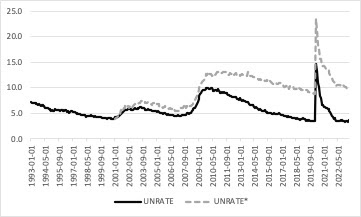Inflation is coming down, as the last BLS report shows. I'm not going to get into that into this (very short) post. The disinflation has taken place while the official unemployment remains very low. However, we all know that unemployment measures very poorly the situation in the labor market. My alternative measure, which I make students calculate in macro classes, is what would be the unemployment rate be if the participation rate, which has been declining since the early 2000s (when China entered the WTO; see on that and deindustrialization this very old post), was the same of the last peak (back at the end of the Clinton era) when it was at about 67 percent (see below).
Note that the unemployment rate has a negative relationship with the participation rate, everything else constant. The result below.
The answer is, not 3.7 percent, but around 10 percent. In other words, there's a lot of what Joan Robinson used to call disguised unemployment. Discouraged workers that are not searching for a job, because they can't find anything worthwhile, and, hence, do not count as unemployed. This can be seen as the extra unemployment that we have because of the neoliberal policies of the last four decades, but in particular after the more radical opening to China starting in the 1990s.
.png)

Don't you believe the aging of the labor force explains some of the decline in the LFPR?
ReplyDeleteOnly partially, and not in a significant way. I'll write on that soon. Including other demographic stories that I think are incorrect (e.g. regarding low interest rates). Sorry for the delay in replying
ReplyDelete